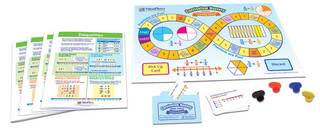The Slopeometer is a simple device to help students quickly and effectively learn and apply the mathematical concept of slope.
Made of sturdy, transparent plastic the Slopeometer securely attaches to any magnetic surface. Place the Slopeometer on the line being measured and the arrow moves to show the precise measurement of slope from 0 to infinity, positive and negative. From simple slope-intercept equations to the complex sketching of derivative functions in a calculus class, educators will find the Slopeometer an invaluable demonstration tool. Includes comprehensive activity guide.
Measures approximately 14” x 7 3/8”
Slopeometer: The Teaching Aid that Invented Itself
By: Eric Olson
Mathematics Department Chair - Pingree School - Hamilton, MA
As the proverb claims, Slopeometer was born out of necessity. It happened when I was teaching calculus but has since proven incredibly useful in a variety of ways--from a middle-school setting on up. The inspiration came when I kept tracing along the graph of a function while I asked my AP calculus students at each point to “imagine the slope of the tangent line” as it gradually changed--from negative to zero to positive--representing the values of the “derivative” of the function.
When, after some puzzled looks from my students, I said “imagine a plumb bob, always pointing to the correct value as it changes slope…” the lightbulb moment happened. Over the weekend, after a trip to a building supply store, I was able to cut a semicircle out of a piece of plexiglass and mark it with appropriate numbers and fractions, then loosely fasten a gravity-activated indicator arm that did the pointing... and presto!--the Slopeometer. My students found it much easier to picture the process, often called “curve-sketching,” and apply it to their own work. My students found it so helpful. Slopeometer has since proven useful in many areas: from “best fit” regression lines, to estimating tangent ratios, to slope-fields for differential equations--but the device has shown to be especially useful when first introducing slope.
A Visual Tool for Understanding Slope In mathematics, the concept of the slope of a line is fundamental for success. Slope is often introduced in late elementary school and applied right up through differential equations. Every beginning math student who learns to graph a line on an x-y coordinate plane will know the convention that mathematical slope--commonly described as the “rise over run”--is a numerical ratio. Every algebra student is confronted with the challenge of understanding the “slope-intercept” equation for a line (also known as “y = mx + b” form, where the letter “m” stands for the slope, and b the y-intercept). Slope-values can be whole numbers, or decimals, but typically are expressed as reduced fractions.
A teacher might wish he or she had a dollar for every mistaken quiz answer stating that a horizontal line had an undefined slope--most of us could retire early on such a proposition! So, why is there confusion surrounding such a critical concept? Students struggle to understand what the number associated with slope actually means, or how it is determined. Students have great difficulty identifying when a slope is positive or negative, and they confuse a slope of zero (a horizontal line), with an ”undefined slope” or “infinite slope” (a vertical line), and students often invert the slope ratio and divide the horizontal change by the vertical change. Students often struggle mightily when they first try to compute the slope of a line using the formula: m = (y1-y2)/(x1-x2). It is a challenge to remember the formula, and even when used correctly can provide an answer without concrete meaning. By observing how the numerical ratios change in real-time as Slopeometer is moved, and the arrow points at increasing or decreasing values, students make sense of the changing numerical values corresponding to the slope. Students also struggle to simply identify positive and negative slopes--something the markings on Slopeometer constantly reinforce the concept. This, in turn, helps with concepts like positive and negative correlation when working with graphs of data sets, or the simple fact that a tangent ratio can be greater than one--while the sine or cosine ratios cannot.
Making the Connection to Trig Functions
There is more to Slopeometer than graphing lines, however--it can also be very helpful when learning trig ratios. There are simple and accurate angle-measuring devices on the market that can be used for teaching trigonometry--but these do not illustrate the key ratios. Slopeometer gives a numerical ratio, and this can prove very useful in some trigonometric applications. If a protractor is used to draw some acute angle, for example, and students are asked to guess the Tangent ratio of the angle, the inquiring teacher will typically be faced with blank stares. However, with a quick demonstration, the Slopeometer can be used to indicate the simple numerical ratio that is equivalent. Then, a decimal value can quickly be found that is remarkably accurate. This process will impress upon your students the fundamental meaning of the “TOA” part of “Soh-Cah-Toa.” This is just one of many activities that are possible with Slopeometer, and as more are developed, you will find them highlighted here.
Country of Manufacture
China
Material
Plastic
Safety
Choke Hazard -- Not for under 3 yrs.
Product Dimensions
7.75 x 14.5 x .75
UPC
706406119475















